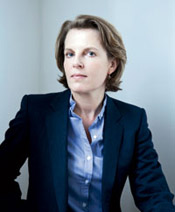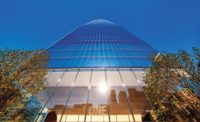New York City
'It is special and ordinary at the same time,' says architect Annabelle Selldorf while standing on West 20th Street in Manhattan's Chelsea neighborhood. She's gazing at the board-formed-concrete facade of the new gallery her firm has designed for art dealer David Zwirner. The exterior has the texture and warmth of Le Corbusier's b'ton brut and the precision of Tadao Ando's poured-in-place structures. With rows of teak-framed windows set just a few inches in, the elevation reads as both a skin, stretched taut, and a hefty, weight-bearing mass. It acknowledges two seemingly incongruous aspects of the surroundings, making a nod to the area's not-so-distant gritty past while seeming perfectly at home in a district now dominated by art galleries and the High Line.
With this clean slate, Selldorf's team has created a 30,000-square-foot building primarily of reinforced concrete. It houses an ensemble of spaces conceived for secondary-market sales (the category includes older pieces by Zwirner's artists or pieces from the estates he represents), especially large-scale installations like the building's inaugural exhibition featuring the work of Dan Flavin and Donald Judd, presented earlier this year. The main display space'a 65-by-68-foot, and roughly 18-foot-tall, column-free room topped by four north-facing light monitors'occupies most of the ground level. An L-shaped, five-story volume containing more intimate exhibition spaces, private viewing rooms, offices, and support areas wraps the main gallery. The configuration allows almost all of the building to be illuminated by daylight, despite its midblock location with structures directly to the east and west.
The materials and color palette are restrained: white walls, and floors of concrete, oak plank, or, in a few places, travertine, keep the focus on the artists' work. But the building's interior has one dramatic architectural statement'a skylit stair connecting all five floors and defined by the same exquisitely crafted board-formed concrete found on the exterior.
Constructing the formwork for the stairway's walls was a process akin to cabinetmaking, according to Julie Hausch-Fen, Selldorf Architects' project manager. For example, the grade of pine for the 8-inch-wide tongue-and-groove boards was selected to produce just the right amount of wood-grain texture, including knots, on the concrete's surface; the length of each board was carefully considered so that the vertical joints would not align; and corners were sealed with gaskets to ensure crisp edges.
The steps that cantilever from these walls were made with smooth forms, but their details are no less exacting than those for the surrounding walls. They are incredibly thin'the depth of each run's throat (the narrowest point where the tread meets the riser) is only 3 inches. A half-inch reveal between the steps and the wall reduces this dimension even further, and it creates the impression that the stair is almost floating. Of course there is plenty of steel inside the concrete to ensure its structural integrity, but the amount of rebar and the slenderness of the stair's components made for challenging pours, says Hausch-Fen.
The meticulously designed stair and countless other details conspire to create a museum-quality environment. This characterization extends to invisible features, such as climate controls that maintain temperature and humidity within the tight range that museums demand of other institutions wanting to borrow pieces from their collections. In addition, the mechanical equipment is highly efficient: along with elements such as planted roofs, a thermally robust building envelope with triple-glazed windows, and low-consumption plumbing fixtures, the climate controls have put the project on track for LEED Gold.
Although certification is an impressive goal (the project is expected be the first commercial gallery to achieve a LEED rating), other elements more directly affect the experience of the architecture, though in subtle ways. The most significant is the daylight entering through windows and skylights, which gently pulls visitors from space to space. There are also a few sleights of hand, including the loading dock ingeniously incorporated into the facade composition and concealed behind an oversized, frosted-glass sliding door. Such devices become apparent only gradually. The approach is 'the architectural equivalent of slow food,' says Selldorf. 'Not everything reveals itself at first glance.'

|
| Photo © Dean Kaufman |
A conversation with: Annabelle Selldorf
Selldorf started her practice 25 years ago after working for Richard Gluckman Architects and Fox & Fowle Architects. Her first solo project was a 'tiny little' kitchen renovation, followed by the renovation of a kitchen and two baths, and then an apartment. Since that time, the scale and variety of her work has grown. The 50-person firm has designed both public and private spaces, including museums, libraries, and an almost-complete 125,000-square-foot recycling facility in Brooklyn. With the help of her three partners'Sara Lopergolo, Lisa Green, and Bill Bigelow'Selldorf is able to maintain involvement in all of the office's work and collaborate with the entire staff. 'It is an interesting reality that one person has to take a leadership role,' she says. 'But leadership isn't about pulling rank. It is about shaping a direction.'
PeopleOwner: David Zwirner
Architect:
Personnel in architect's firm who should receive special credit:
Project Team:
Consultant(s): General contractor: Eurostruct
Photographer(s): CAD system, project management, or other software used: AutoCAD 2013, THERM, WUFI Size: 30,000 square feet Cost: withheld Completion date: February 2013 |
Products
Structural system
Exterior Artistic Windows & Doors, Custom Teak Storefront
North fa'ade
Stucco system:
Building Envelope
North Façade
Roofing
Standing Seam Metal Roof – Main Exhibition Skylights
Windows
North façade
Glazing
Store Front System:
Hardware
Hinges:
Locks:
Flooring
A&G Marble, ¾” Travertine, Mocha, Honed Finish:
Dinesen Wood Floors, 12” White Oak:
Paint
Window treatments
DFB, Roman shades, Lanalino fabric
DFB Sol-r-shades, White fabric
Furnishings
Lighting
Nulux, Washlux 3 incandescent wall washer
Edison Price-recessed track SLRR-Aluminum finish
Philips, stacklite metal halide wall washer track heads-STK MH T4-70-120 2C-UVF
Philips, stacklite halogen wall washer track heads – STK 150 WHT-UVF
Pinnacle, T8 linear fixtures
Switching:
Conveyance
Plumbing
Faucets:
Toilets:
Energy
Other unique products: |













